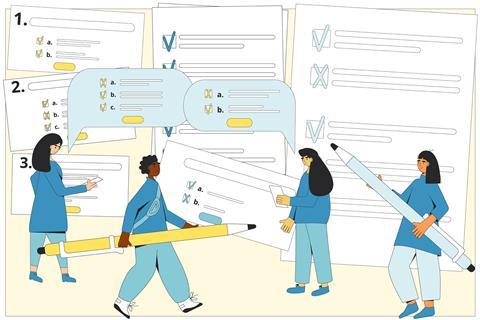Prepare the ground for continued learning and exam progress by adding DIRT to your test reviews

It’s a familiar routine: you announce a test and panic ensues. You mark and return it. A shouting match ensues … ‘What percentage did you get?’, ‘What did you put for question 1?’ or ‘Why didn’t I get this mark but she did?’ You display the mark scheme, and file the test away.
Emerging research reveals the true extent of test anxiety among adolescents, and it’s clear that current approaches to testing contribute. Students are focused on their scores rather than on learning.
Spending lesson time scrolling through a mark scheme can mean wasted learning opportunities. Lower attainers scribble corrections, while higher attainers sit back with nothing to do. So we give the lower attainers more work, while telling the top end learners their learning is finished. Instead, I have been integrating DIRT – dedicated improvement and reflection time – tasks, aiming to shift the focus back to learning. I also want to provide balanced workloads and push learning forward for all, hopefully making the experience more positive for my students.
Why it works
This approach helps relieve assessment anxiety. Students are focused on their learning rather than their attainment. My classes are more engaged, and the classroom atmosphere feels purposeful and supportive. I can circulate to provide support or push learning forward instead of standing at the front; my time is freed up to discuss progress and put attainment into context.
The task sends a positive message that everyone has equitable amounts of work, regardless of their attainment – students know the learning is not complete. I model effective revision strategies and everyone understands their next steps to prepare for future assessments.
How to build a DIRT test review
First, break a test question down to its core to determine what it’s trying to achieve. Consider three points.
- Question: which area of the specification was the focus?
- Consolidate: how could you break the question down to help students access it?
- Stretch: how could you use the context of the question to push learning forward?
First, break a test question down to its core to determine what it’s trying to achieve. Consider three points. First, which area of the specification was the focus (question)? How could you break the question down to help students access it (consolidate)? And how could you use the context of the question to push learning forward (stretch)?
I build a review task using these questions as my lesson starter, and then students work independently on it for 10 to 15 minutes. The task either guides them towards particular questions, or they self-select.
1. Question
Break down the core of the question. Think about: specification points, learning objectives, command words and the required skills, knowledge and application. Showcasing this process helps students pick apart exam questions and understand how to answer them effectively. It can also help identify areas of strength and weakness.
2. Consolidate
How could you scaffold learning? You might model examples for students to mark or thinking processes. You could explore the requirements of the command word, for example explain versus describe versus evaluate. You could also direct students to a resource for further practice. Alternatively, take the route of modelling how to consolidate learning by showcasing effective revision tips.
3. Stretch
What steps could you take to increase the demand of this question? Consider:
- altering the command word to increase challenge.
- removing scaffolding to make the question unstructured.
- applying the same skill to a different context.
- applying the knowledge to something unfamiliar.
What steps could you take to increase the demand of this question? Consider altering the command word to increase the challenge, or perhaps removing scaffolding to make the question unstructured. You could apply the same skill to a different context or the knowledge to something unfamiliar.
It helps to have some tasks to hand which lead your students through this thought process. For example: ‘How would you change your answer if the command word were explain instead of describe?’ or ‘If the question asked about halogens instead of alkali metals, how would your answer be different?’
After this, spend five minutes answering remaining queries, or reviewing the mark scheme for particularly challenging questions.
Considerations
This may feel like an extra task to add to your growing workload. I am not suggesting every question requires review, which would be time-consuming and not necessarily helpful. Selecting between three and five key questions is plenty to get the message across. This is about knowing your students – you are best placed to identify and target areas of weakness or where you can offer challenge.
Gradually, you will build a bank of questions, many of which you are probably already asking. There’s a wealth of resources out there to use. My experience is that DIRT review is an invaluable feedback tool and has been worth every minute of my time – and my students love it, too.
Louise Hussein














No comments yet